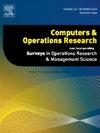A fully adaptive framework for continuous-state stochastic dynamic programming
IF 4.3
2区 工程技术
Q2 COMPUTER SCIENCE, INTERDISCIPLINARY APPLICATIONS
引用次数: 0
Abstract
Approximate dynamic programming (ADP) carries out approximation of the future value function (FVF) to enable numerical solutions to dynamic programming (DP). Recent ADP methodologies often employ the design and analysis of computer experiment (DACE) techniques for the FVF approximation. Use of DACE-based ADP approach, however, creates a “chicken and egg” situation where we cannot collect the data for statistical modeling until we know the state space region, but we do not know the state space region until we collect the data. To overcome this dilemma, this paper introduces a sequential state space exploration (SSSE) approach to adaptively identify the state space region for the experimental design while also sampling useful data for the statistical model. In the proposed methodology, the SSSE approach works in tandem with an adaptive value function approximation (AVFA) algorithm that gradually grows the complexity of the statistical model as more data are observed. This novel SSSE-AVFA approach features a “fully adaptive dynamic programming” algorithm, which can automatically and appropriately identify the three critical components (state space region, sample size of the data, and statistical model structure) for FVF approximation, thereby eliminating the need for time-consuming trial-and-error computational runs that were previously required. The SSSE-AVFA approach is examined with a nine-dimensional inventory forecasting problem and is compared with fixed structure runs in which the state space region, sample size of the data, and statistical model structure are assumed in advance. Our proposed methodology ensured either that the established solutions could be more reasonable or that the modeling process could effectively save the computational effort. With its full adaptiveness in determining those critical components, the SSSE-AVFA approach has the potential to be more effective and efficient than the traditional methods in handling a wide range of real-world continuous-state DP problems.
连续状态随机动态规划的全自适应框架
近似动态规划(ADP)是对未来值函数(FVF)进行逼近,从而实现动态规划(DP)的数值求解。最近的ADP方法通常采用计算机实验设计和分析(DACE)技术来逼近FVF。然而,使用基于dace的ADP方法会产生一个“先有鸡还是先有蛋”的情况,在我们知道状态空间区域之前,我们无法收集统计建模的数据,但是在收集数据之前,我们不知道状态空间区域。为了克服这一困境,本文引入了一种序列状态空间探索(SSSE)方法来自适应地识别实验设计的状态空间区域,同时为统计模型采样有用的数据。在提出的方法中,SSSE方法与自适应值函数近似(AVFA)算法协同工作,随着观察到的数据越来越多,该算法逐渐增加统计模型的复杂性。这种新颖的SSSE-AVFA方法具有“完全自适应动态规划”算法,可以自动适当地识别FVF近似的三个关键组成部分(状态空间区域、数据样本大小和统计模型结构),从而消除了以前需要的耗时的试错计算运行。通过一个九维库存预测问题对SSSE-AVFA方法进行了检验,并与预先假设状态空间区域、数据样本量和统计模型结构的固定结构运行进行了比较。我们提出的方法既保证了所建立的解更加合理,又保证了建模过程有效地节省了计算量。SSSE-AVFA方法在确定这些关键成分方面具有完全的适应性,在处理广泛的现实世界连续状态DP问题方面,它比传统方法更有效和高效。
本文章由计算机程序翻译,如有差异,请以英文原文为准。
求助全文
约1分钟内获得全文
求助全文
来源期刊

Computers & Operations Research
工程技术-工程:工业
CiteScore
8.60
自引率
8.70%
发文量
292
审稿时长
8.5 months
期刊介绍:
Operations research and computers meet in a large number of scientific fields, many of which are of vital current concern to our troubled society. These include, among others, ecology, transportation, safety, reliability, urban planning, economics, inventory control, investment strategy and logistics (including reverse logistics). Computers & Operations Research provides an international forum for the application of computers and operations research techniques to problems in these and related fields.
 求助内容:
求助内容: 应助结果提醒方式:
应助结果提醒方式:


